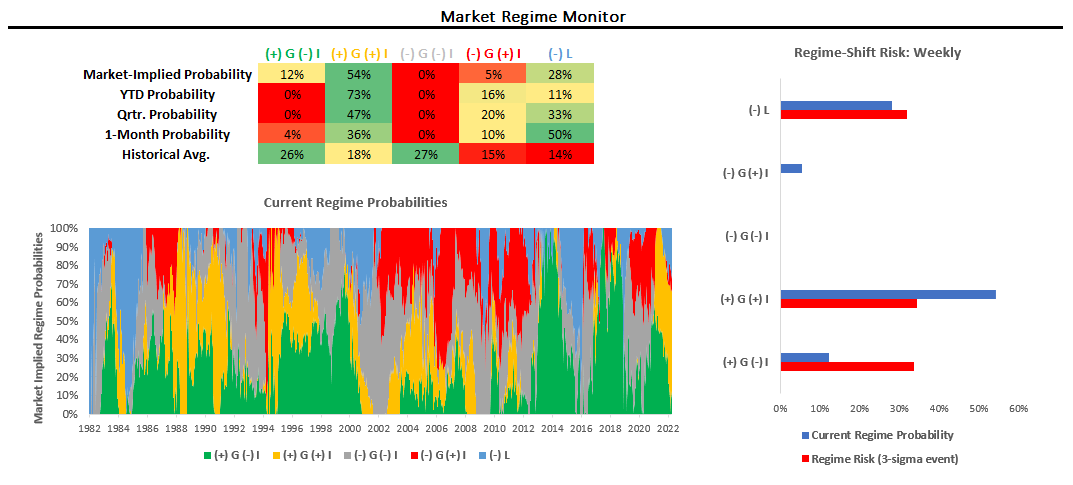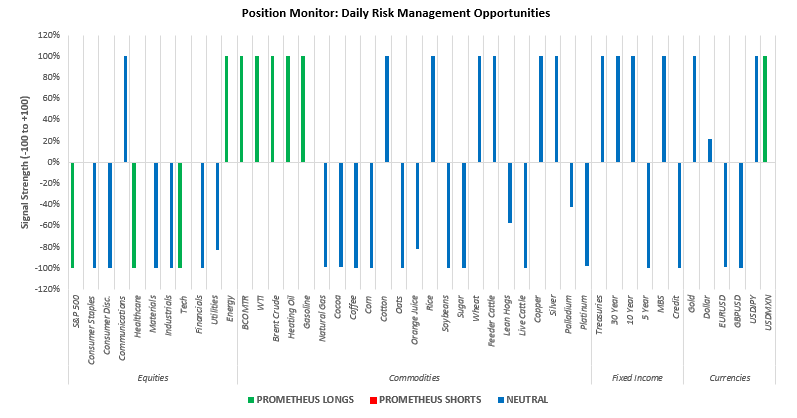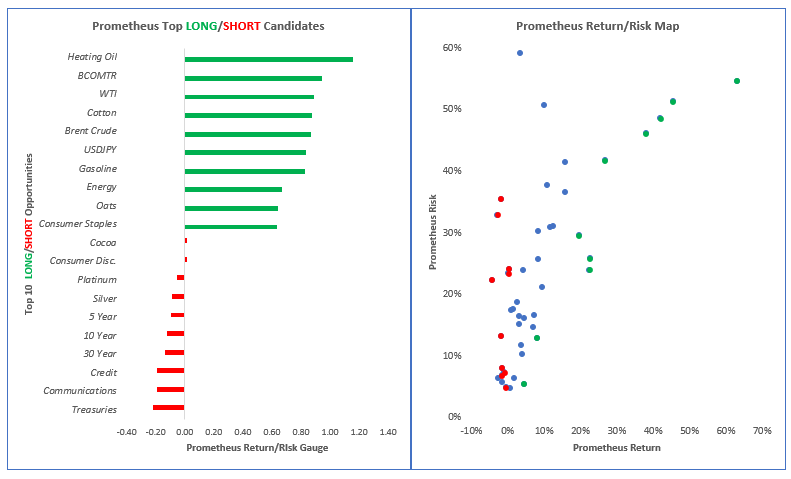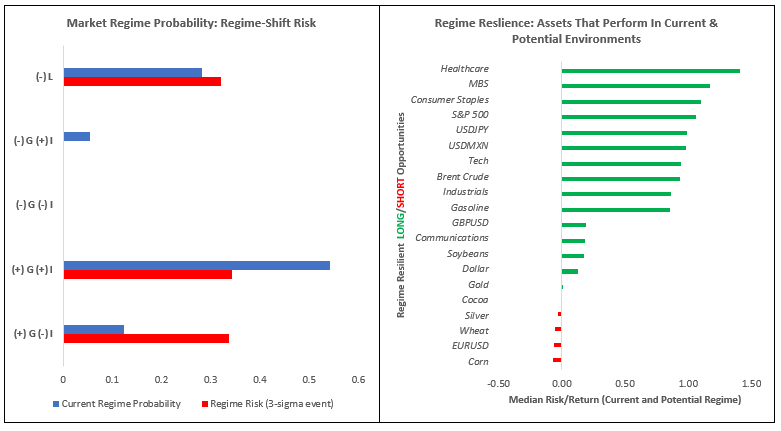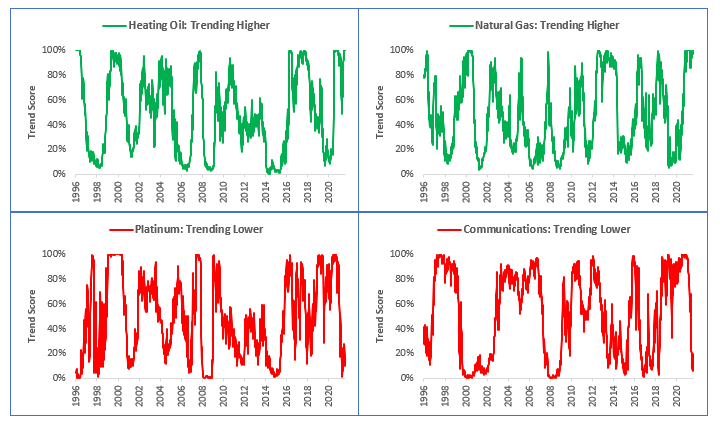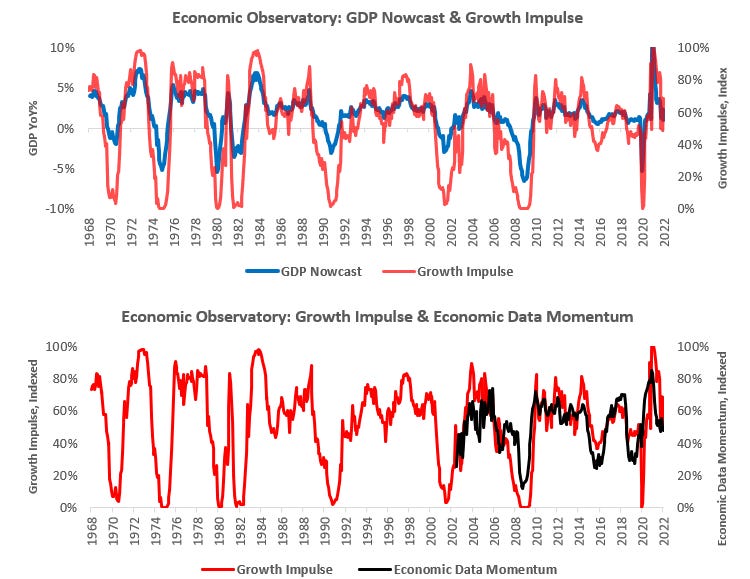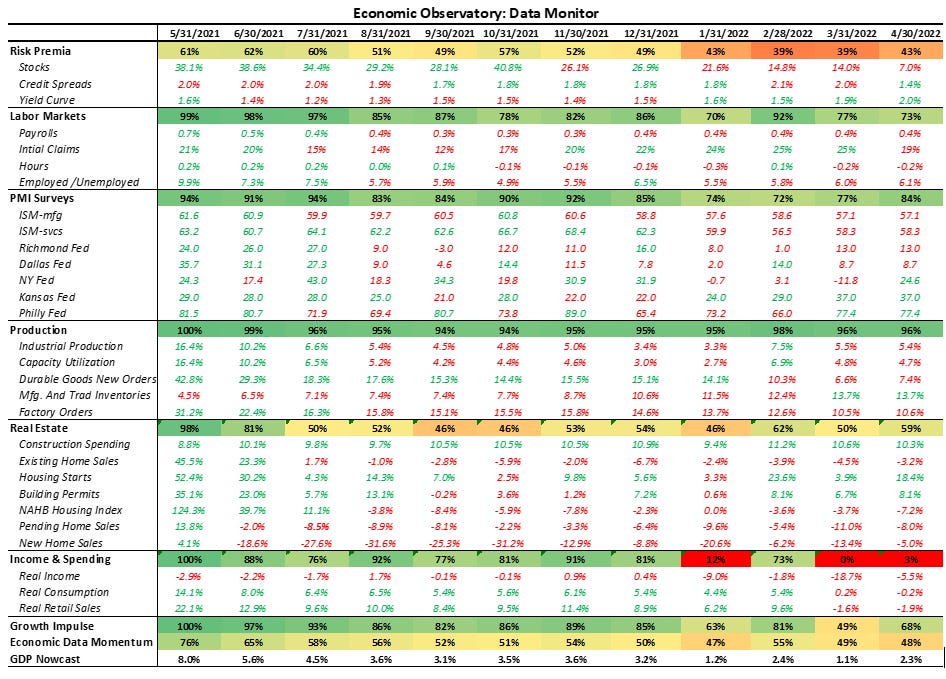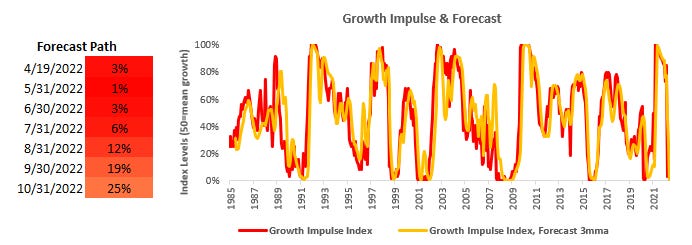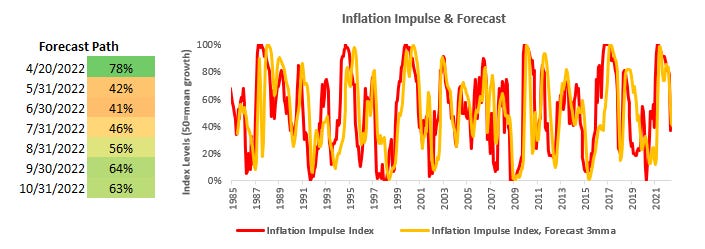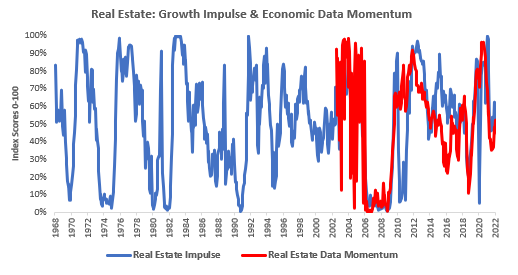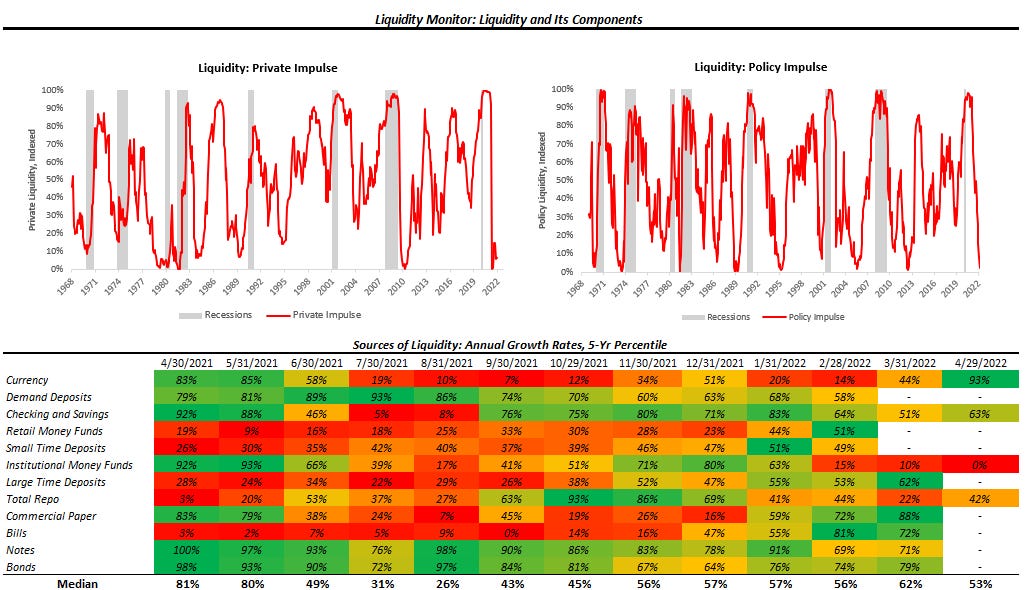Welcome to The Observatory. The Observatory is how we at Prometheus monitor the evolution of both the economy and financial markets in real-time. Without further ado, let's dive into what our systems are telling us:
Markets: This week has proven to be tough for our Alpha Strategy. While we have generally been on the right side of the equity bounce, our Market Regime sizing led to overweights in the Commodities, which have shown weak performance since last week. In the FX and Equity space, our bets have performed well in aggregate. Within Equities, we highlight the value that Energy stocks currently provide: i) they have shown generally low correlations to broader beta, and ii) they have shown strong trend characteristics, further differentiating them from equities. These characteristics make them a strong addition to those limited to equity exposure. To summarize our systems' current assessment: Over the last month, markets have primarily priced (-) L. Nonetheless, our Market Regime Monitors tell us we are in a (+) G (+) I regime. Regime Risk is currently low, with a regime change unlikely. Regime Risk is currently low, with a regime change unlikely. In light of the current Regime Risk, the most regime resilient positions are LONG: Healthcare & MBS and SHORT: Corn & EURUSD. Our Trend Monitors show that the strongest UP trends in markets are in Heating Oil & Natural Gas, and the strongest DOWN trends are in Platinum & Communications. Strategically, our systems estimate that the best return/risk characteristics are LONG: Heating Oil & BCOMTR and SHORT: Treasuries & Communications. Currently, the Prometheus Alpha Strategy is LONG: S&P 500, Healthcare, Tech, Energy, BCOMTR, WTI, Brent Crude, Heating Oil, Gasoline, USDMXN. Our Beta Rotation Strategy is currently LONG: Commodities. A Market Regime Portfolio would be allocated to Stocks: 12.3%, Commodities: 54.2%, Treasuries: 0%, Gold & TIPS: 5.4%, Cash: 28.2%.
Macro: Recently, elevated commodities have resulted in our inflation forecasts showing sustained above-trend inflation. This continues to be an issue for the economy, creating a dynamic where policy makers have to reactively adjust short-end rates to attempt to curb inflation. This dynamic creates an alternative correlation regime for the dollar and commodities, i.e. the dollar shows strength alongside commodites. This dynamic lasts until it breaks itself.
To summarize our systems' current assessment: Our GDP Nowcast currently estimates GDP growth of 2.29%. Further, our GDP Nowcast currently shows a positive Growth Impulse, i.e., growth is above trend. Data has recently surprised to the downside, with Economic Data Momentum at 47.6%. Our Growth Impulse forecasts show growth accelerating but remaining below trend over the next six months. Our Inflation Impulse forecasts show inflation decelerating but remaining above trend over the next six months. Our Liquidity Monitors show that Private & Public Sector Liquidity has deteriorated significantly, showing extremely weak readings. This weakness potentiates future liquidity increases, but this is a ways off.
The future is dynamic, and our systems adjust as new information is available. Our bias is to allocate for the existing regime while trying to peek around the corner at what the future may hold. Finally, we optimize these views to minimize portfolio risk, resulting in our trading signals. We show all this in the pages that follow.
Market Regime Monitor
Using our understanding of asset markets, we can estimate the current market-implied regime in terms of growth, inflation, and liquidity:
(+) G (-) I: Rising Growth & Falling Inflation
(+) G (+) I: Rising Growth & Rising Inflation
(-) G (-) I: Falling Growth & Falling Inflation
(-) G (+) I: Falling Growth & Rising Inflation
(-) L: Tightening Liquidity
Markets price these macroeconomic regimes with varying probabilities. We show our estimates for the current market regime below:
Over the last month, markets have primarily priced (-) L. Nonetheless, our Market Regime Monitors tell us we are in a (+) G (+) I regime. Regime Risk is currently low, with a regime change unlikely.
Position Monitor
Below, we show one of our daily Position Monitors, which estimates how cheap or expensive an asset is relative to its expected return, i.e., it is a risk management tool. Assets in the negative territory are ones to book gains in or short, and assets in the positive territory are ones to add to or enter.
Currently, the Prometheus Alpha Strategy is LONG: S&P 500, Healthcare, Tech, Energy, BCOMTR, WTI, Brent Crude, Heating Oil, Gasoline, USDMXN. Our Beta Rotation Strategy is currently LONG: Commodities. A Market Regime Portfolio would be allocated to Stocks: 12.3%, Commodities: 54.2%, Treasuries: 0%, Gold & TIPS: 5.4%, Cash: 28.2%.
Prometheus Return/Risk Profiles
Using our understanding of market-implied regimes alongside portfolio construction principles, we can create a return-on-risk profile for various assets within a given market regime. We show the current regime's full return/risk profile menu and the top Long & Short candidates.
Strategically, our systems estimate that the best return/risk characteristics are LONG: Heating Oil & BCOMTR and SHORT: Treasuries & Communications.
Regime Risk Management: Regime Resilience
While we know the current regime, we are always running the risk of the regime shifting to one that doesn't support our current allocations. To assess this risk, we use cross-asset correlations to shock the current regime and evaluate the likelihood of a regime shift. Further, we then look at the resilience of assets, i.e., their tendency to perform in the event of a regime shift:
Regime Risk is currently low, with a regime change unlikely. In light of the current Regime Risk, the most regime resilient positions are LONG: Healthcare & MBS and SHORT: Corn & EURUSD.
Trend Monitors: Top Trends, Upside & Downside
We also use trend models to augment our market regime signals to assess the degree of multi-duration momentum at the asset class and security level. This gauge allows us to evaluate the degree of trend persistence within a given asset, helping us benefit from solid trends and avoid weak ones. We highlight the top trends in markets today:
Our Trend Monitors show that the strongest UP trends in markets are in Heating Oil & Natural Gas, and the strongest DOWN trends are in Platinum & Communications.
Economic Observatory: GDP Nowcast & Economic Data Momentum
Our economic nowcasting systems aggregate the accelerations and impulses in economic data. However, a significant component of the market's reaction to economic data comes from the evolution of economic data relative to expectations. We standardize this measure to understand momentum in economic data relative to expectations:
Our GDP Nowcast currently estimates GDP growth of 2.29%. Further, our GDP Nowcast currently shows a positive Growth Impulse, i.e. growth is above trend. Data has recently surprised to the downside, with Economic Data Momentum at 47.6%.
Here are some of the underlying data series. Please note that this includes estimates for the most recent months where data is unavailable:
Economic Observatory: Growth & Inflation Forecast Path
Our systematic forecasts for GDP use measures of cyclicality and trend to assess the probable path of Growth & Inflation over the next 6-12 months. We forecast growth and inflation relative to their cycle trends and display their index values, ranging from 0-to 100:
Our Growth Impulse forecasts show growth accelerating but remaining below trend over the next six months. Our Inflation Impulse forecasts show inflation decelerating but remaining above trend over the next 6 months.
Economic Observatory: Real Estate
Real Estate has significant ramifications for the business cycle through the wealth effect channel. The leading relationship between the real-estate sector and consumer spending is well documented and, therefore, a critical variable in assessing growth.
Real Estate data has recently shown a bounce, counter to trend in incomes, spending, and financial markets. Data has both accelerated, and surprised to the upside. This marginally ameriorates broader slowdown pressures.
Economic Observatory: Liquidity Monitor
As shown previously, liquidity is a leading indicator of the economic cycle. Therefore, while we systematically forecast growth and inflation, the leading nature of liquidity precludes us from the need to forecast liquidity but rather keep a close eye on its evolution. To track the evolution of what is essentially economic and financial "dry-powder," we have created our Liquidity Monitor, as shown below:
Our Liquidity Monitors show that Private & Public Sector Liquidity has deteriorated significantly, showing extremely weak readings. This weakness potentiates future liquidity increases, but this is a ways off.
Conclusions
Regime Risk has been alleviated due to heightened inflationary pressures. We are witnessing a regime dynamic unlike in the last decade, and a dynamic approach that considers shifting regimes, correlation characteristics, and return structures is vital.



